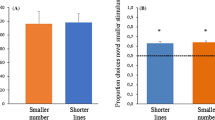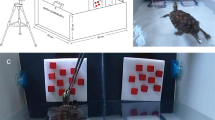Abstract
If a nonhuman animal matches the silhouette “crab” (A) to that of a “tulip” (B) and is further taught to match “tulip” (B) to the silhouette “radio” (C), will it immediately match “radio” (C) to “crab” (A)? To date formation of an equivalence relation of this type has not been demonstrated in animals. In our study, designed to give a sea lion match-to-sample experience with examples of sample and comparison stimuli switching roles, a 7-year-old female (Rio) was trained and tested with 30 potential classes, each consisting of 3 different shapes. Twelve of the 30 classes were used for training relational properties of symmetry and transitivity, and 18 classes were reserved for a final equivalence test. Following an initial failure to do symmetry on the first trial of novel relations (B→A: 8/12), Rio did symmetry (C→B: 11/12) and transitivity. (A→C: 11/12) before mastering equivalence on the first trial of 18 novel relations (C→A: 16/18). Results suggest that equivalence concepts are not mediated by language, but may be a prerequisite for linguistic competence.
Similar content being viewed by others
References
ADAMS, B. J., FIELDS, L., & VERHAVE, T. (1993). Effects of test order on intersubject variability during equivalence class formation. The Psychological Record, 43, 133–152.
BHATT, R. S. (1988). Categorization in pigeons: Effects of category size, congruity with human categories, selective attention, and secondary generalization. Ph.D. thesis: Iowa City: University of Iowa.
CATANIA, A. C. (1980). Autoclitic processes and the structure of behavior. Behaviorism, 8, 175–186.
CATANIA, A. C. (1992). Learning ( 3rd ed.). Englewood Cliffs, NJ: Prentice Hall.
CHENEY, D. L., & SEYFARTH, R. M. (1990). How monkeys see the world. Chicago: University of Chicago Press.
D’AMATO, M. R., SALMON, D., LOUKAS, E., & TOMIE, A. (1985). Symmetry and transitivity of conditional relations in monkeys (Cebus apella) and pigeons (Columba livia). Journal of the Experiment Analysis of Behavior, 44, 35–47.
DUGDALE, N., & LOWE, C. F. (1990). Naming and stimulus equivalence. In D. Blackman & H. Lejeune (Eds.), Behavior analysis in theory and practice (pp. 115–138). Hillsdale, NJ: Erlbaum.
GISINER, R., & SCHUSTERMAN, R. J. (1992). Sequence, syntax and semantics: Responses of a language-trained sea lion (Zalophus californianus) to novel sign combinations. Journal of Comparative Psychology, 106, 78–91.
HAYES, S. C. (1989). Nonhumans have not yet shown stimulus equivalence. Journal of the Experimental Analysis of Behavior, 51, 385–392.
HERMAN, L. M. (1988). The language of animal language research: Reply to Schusterman and Gisiner. The Psychological Record, 38, 349–362.
HERMAN, L. M. (1989). In which procrustean bed does the sea lion sleep tonight? The Psychological Record, 39, 19–42.
KASTAK, D. A., & SCHUSTERMAN, R. J. (1992). Comparative cognition in marine mammals: A clarification on match-to-sample tests. Marine Mammal Science, 8, 414–417.
KASTAK, D., & SCHUSTERMAN, R. J. (1993). Immediate transfer of visual identity matching-to-sample in two California sea lions (Zalophus californianus). Manuscript submitted for publication.
KENNEDY, C. H. (1991). Equivalence class formation influenced by the number of modes separating stimuli. Behavioral Processes, 24, 219–245.
LIPKENS, R., KOP, P. F. M., & MATTHIJS, W. (1988). A test of symmetry and transitivity in the conditional discrimination of performances of pigeons. Journal of the Experimental Analysis of Behavior, 49, 395–409.
MARKL, H. (1985). Manipulation, modulation, information, cognition: Some of the riddles of communication. In B. Holldobler & M. Lindauer (Eds.), Experimental behavioral ecology and sociobiology (pp. 163–194). Sunderland, MA: Sinauer Associates.
PREMACK, D. (1986). “Gavagai” or the future history of the animal language controversy Cambridge, MA: Mit Press.
SAVAGE-RUMBAUGH, E. S. (1986). Ape language: From conditioned response to symbol. New York: Columbia University Press.
SAVAGE-RUMBAUGH, S., MC DONALD, K., SEVCIK, R. A., HOPKINS, W. D., & RUBERT, E. (1986). Spontaneous symbol acquisition and communicative use by pygmy chimpanzees (Pan paniscus). Journal of Experimental Psychology. General, 115, 211–235.
SCHUSTERMAN, R. J., (1990). Stimulus equivalence and cross-modal perception: A testable model for demonstrating symbolic representations in bottlenose dolphins. In J. Thomas & R. Kastelein (Eds.), Sensory abilities of cetaceans (pp. 677–684). New York: Plenum Press.
SCHUSTERMAN, R. J., & GISINER, R. (1988). Artificial language comprehension in dolphins and sea lions: The essential cognitive skills. The Psychological Record, 38, 311–348.
SCHUSTERMAN, R. J., & GISINER, R. (1989). Please parse the sentence: Animal cognition in the Procrustean bed of linguistics. The Psychological Record, 39, 3–18.
SCHUSTERMAN, R. J. & GISINER, R. (in press). Pinnipeds, porpoises and parsimony: Animal language research viewed from a bottom-up perspective. In R. W. Mitchell, H. L. Miles, & N. S. Thompson (Eds.), Anthropomorphism, anecdotes, and animals: The emperor’s new clothes? Lincoln: University of Nebraska Press.
SCHUSTERMAN, R. J., GISINER, R., GRIMM, B. G., & HANGGI, E. B. (1993). Behavior control by exclusion and attempts at establishing semanticity in marine mammals using matching-to-sample paradigms. In H. Roitblat, L. Herman, & P. Nachtigall (Eds.), Language and communications: A comparative perspective (pp. 249–275). Hillsdale, NJ: Erlbaum.
SCHUSTERMAN, R. J., GRIMM, B. K., GISINER, R., & HANGGI, E. B. (1991). Retroactive interference of delayed “symbolic” matching-to-sample in California sea lions. Paper given at the Annual Meeting of the Psychonomic Society in San Francisco.
SCHUSTERMAN, R. J., HANGGI, E. B., & GISINER, R. (1992). Acoustic signalling in mother-pup reunions, interspecies bonding, and affiliation by kinship in California sea lions (Zalophus californianus). In J. Thomas, R. Kastelein, & A. Supin (Eds.), Marine mammal sensory systems (pp. 533–551). New York: Plenum Press.
SIDMAN, M. (1971). Reading and auditory-visual equivalences. Journal of Speech and Hearing Research, 14, 5–13.
SIDMAN, M. (1990). Equivalence relations: Where do they come from? In D. Blackman & H. Lejuene (Eds.), Behavior analysis in theory and practice: Contributions and controversies (pp. 93–114). Hillsdale, NJ: Erlbaum.
SIDMAN, M., RAUZIN, R., LAZAR, R., CUNNINGHAM, S., TAILBY, W., & CARRIGAN, P. (1982). A search for symmetry in the conditional discriminations of rhesus monkeys, baboons, and children. Journal of the Experimental Analysis of Behavior, 37, 23–44.
SIDMAN, M., & TAILBY, W. (1982). Conditional discrimination vs. matching to sample: An expansion of the testing paradigm. Journal of the Experimental Analysis of Behavior, 37, 5–22.
TERRACE, H. S. (1986). Nim: A chimpanzee who learned sign language. New York: Columbia University Press.
THOMAS, R. K. (1980). Evolution of intelligence: An approach to its assessment. Brain Behavior and Evolution, 17, 454–472.
TOMONAGA, M., MATSUZAWA, T., FUJITA, K., & YAMAMOTO, J. (1991). Emergence of symmetry in visual conditional discrimination by chimpanzees (Pan troglodytes). Psychological Reports, 68, 51–60.
WRIGHT, A. A., COOK, R. G., RIVERA, J. J., SANDS, S. F., & DELIUS, J. D. (1988). Concept learning by pigeons: Matching-to-sample with trial-unique video picture stimuli. Animal Learning and Behavior, 18, 287–294.
Author information
Authors and Affiliations
Additional information
The experimental work reported in this paper was funded by contract N00014-85-K-0244 from the Office of Naval Research and by a grant from the Center for Field Research to Ronald J. Schusterman. Bob Gisiner, Brigit Grimm, Evelyn Hanggi, Michel Coulliais, and Ema Spada helped enormously during the early stages of this project and we thank them for their many contributions. Later on Colleen Reichmuth, Tammy Berger, Alyson Henschel, Leif Johnson and several student interns and assistants and many Earthwatch volunteers gave us invaluable assistance.
Rights and permissions
About this article
Cite this article
Schusterman, R.J., Kastak, D. A California Sea Lion (Zalophus Californianus) is Capable of Forming Equivalence Relations. Psychol Rec 43, 823–839 (1993). https://doi.org/10.1007/BF03395915
Published:
Issue Date:
DOI: https://doi.org/10.1007/BF03395915




